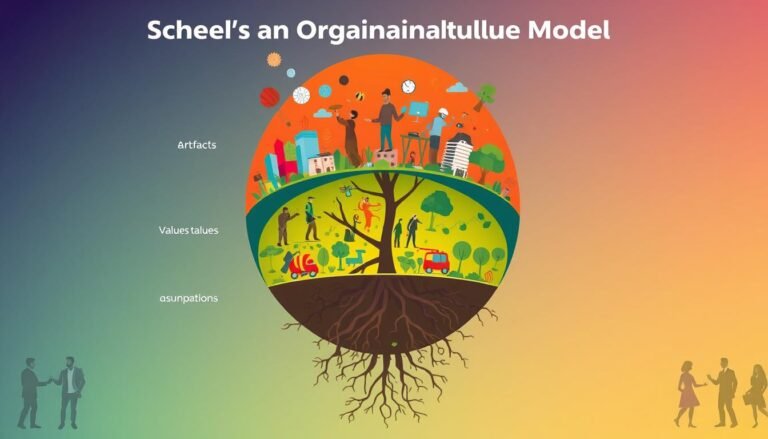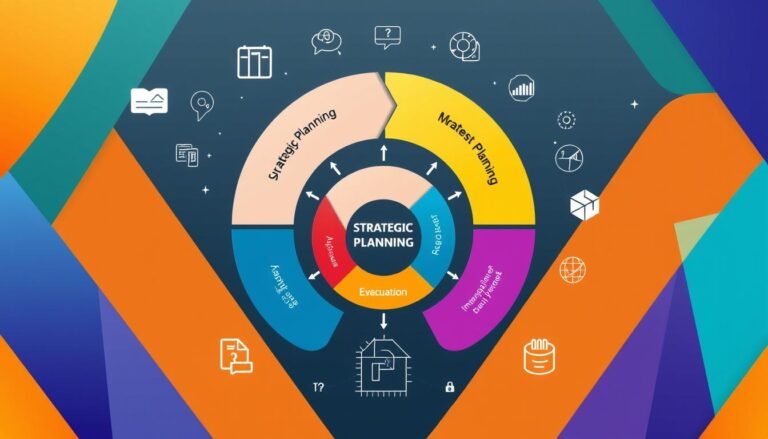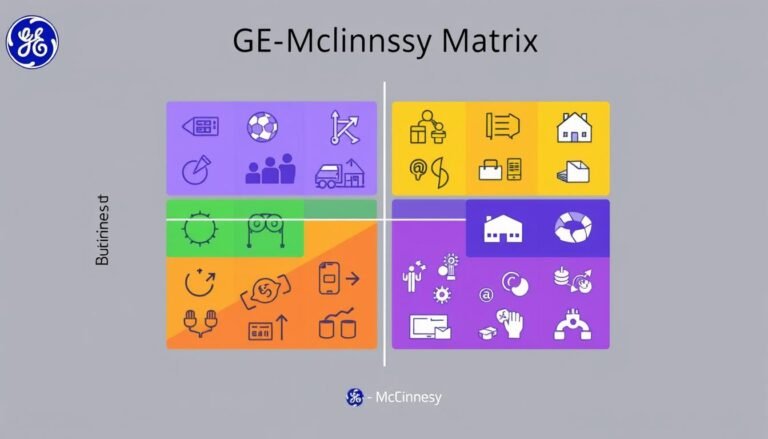Understanding Prospect Theory in Decision Making
Have you ever felt a loss was worse than a gain of the same size? This is what Prospect Theory is all about. It was created by Daniel Kahneman and Amos Tversky in 1979. It helps us understand how we make decisions, especially when dealing with risk and uncertainty.
This theory shows that when we face choices with possible gains and losses, we often make biased decisions. We tend to prefer certain outcomes over likely ones. Losses affect us more emotionally than gains, making us cautious with big risks and more daring with small ones.
Learning about Prospect Theory helps us see how we make decisions. It also gives insights into finance, policy-making, and marketing.
Key Takeaways
- Prospect Theory was developed by Kahneman and Tversky in 1979 to explain decision-making under risk.
- Individuals often perceive potential gains and losses as a 50/50 chance, skewed towards gains.
- Loss aversion indicates that losses have a greater emotional weight than equivalent gains.
- People exhibit risk-averse behaviors when stakes are high and tend to accept risks when stakes are low.
- The framing effect can significantly impact the choices individuals make in various contexts.
What is Prospect Theory?
Prospect Theory is a big step forward in understanding how we make decisions when things are uncertain. It’s a key idea in behavioral economics. It shows how our psychology affects our financial choices, unlike old economic theories.
Definition and Origin
Prospect Theory explains how we see gains and losses when deciding in uncertain situations. Daniel Kahneman and Amos Tversky came up with it in 1979. Kahneman got the Nobel Prize in Economics in 2002 for this work. This theory tells us a lot about loss aversion, where we feel losses more than gains. This makes us risk-averse when we could gain something.
Key Concepts of Prospect Theory
This theory brings new ideas that change how we see making decisions with risk:
- Value Function: The value function is s-shaped and not the same for gains and losses, with steeper slopes for losses.
- Loss Aversion: We feel losses more than gains of the same size, which affects our choices.
- Cognitive Biases: We focus too much on unlikely events and not enough on likely ones, showing how we distort probability.
- Two-Stage Decision Process: Prospect Theory says we make decisions in two steps: editing and evaluating.
Historical Background by Kahneman and Tversky
Kahneman and Tversky showed that old economic ideas, like thinking a $10 gain equals a $10 loss in sadness, aren’t right. Their tests showed people often choose safety over possible risks. This leads to choices that don’t fit with rational thinking. For example, they found people like insurance more because of loss aversion and how risk is framed.
| Key Concepts | Description |
|---|---|
| Value Function | S-shaped and asymmetrical with steeper losses than gains |
| Loss Aversion | Feeling losses more acutely than equivalent gains |
| Cognitive Biases | Overweighting of low-probability events |
| Decision Process | Editing and evaluation phases in decision-making |
How Prospect Theory Influences Decision Making
Prospect Theory helps us understand how people make choices when faced with risk and uncertainty. It shows that we don’t always make rational decisions. Our choices can be swayed by our feelings and other psychological factors.
Decisions Under Risk and Uncertainty
When making decisions under uncertainty, people often weigh potential losses against gains. Studies during big events like the Paris terror attacks and the COVID-19 pandemic showed how people’s choices changed. For example, a study with 4,098 participants from 19 countries found that emotions greatly influenced their decisions.
The Role of Cognitive Biases in Decision-Making
Cognitive biases can distort our judgment, especially when making risky decisions. Kahneman and Tversky found three main biases: loss aversion, certainty bias, and the isolation effect. Loss aversion makes us feel more emotional about losses than gains, leading to risk-taking to avoid loss.
Understanding the Framing Effect and its Implications
The framing effect shows how choice presentation affects decision-making. It reveals that framing a situation as a loss or a gain changes how people respond. Marketing uses this bias, saying “last chance” to make us act quickly. This shows how framing can deeply influence our choices under uncertainty.
Characteristics of Prospect Theory
Prospect Theory helps us understand how people make choices when there’s risk and uncertainty. It shows us the complex ways we behave, especially when it comes to avoiding losses, preferring sure things, seeing risks, and changing probabilities.
Loss Aversion: The Core Principle
Loss aversion is key to Prospect Theory. It says people feel losses more deeply than gains of the same size. This makes people choose options that avoid losses over those that could bring bigger gains. The fear of losses makes people act cautiously in money matters, affecting their risk-taking.
Certainty Preference and Risk Perception
People prefer sure things over risky ones, even if the risky ones could bring more rewards. This comes from a fear of the unknown. In areas like investing or insurance, many choose safe options over ones that could lead to bigger gains.
Discounting Small Probabilities and Relative Positioning
Prospect Theory also tells us to overlook small chances, which can lead to bad decisions, especially in big situations. It also says we make choices by comparing ourselves to others. We base our decisions on how we think we stack up socially and financially.
Practical Applications of Prospect Theory
Prospect Theory helps us understand how people make choices in finance and marketing. It shows us how people decide on investments, market behavior, and what consumers do. This knowledge is very useful.
Effects on Investment Choices
When it comes to investing, people often prefer safe options over risky ones. They feel losses more deeply than gains. This affects how investment strategies are made, leaning towards stable returns.
People also value what they own more than what they don’t. This can make them sell things for more than they bought them for.
Behavior in Financial Markets
Prospect Theory also shapes how people act in financial markets. Investors often keep losing investments too long, known as the disposition effect. They are more scared of losing money than happy about making it.
This goes against traditional financial ideas. Changes in how people see things can change what they prefer, leading to unexpected choices.
Impacts on Consumer Behavior and Marketing Strategies
Marketers use Prospect Theory to understand what consumers want. How they frame information can greatly affect buying decisions. For instance, focusing on the loss of not buying something can work better than just talking about gains.
Using these insights, marketing strategies can be more effective. This can lead to better engagement and sales.
| Aspect | Application |
|---|---|
| Investment Choices | Risk aversion leads to a focus on stable returns over risky assets. |
| Financial Markets | Disposition effect causes investors to hold losing positions too long. |
| Consumer Behavior | Framing strategies can sway purchasing decisions significantly. |
| Marketing Strategies | Highlighting losses can drive consumer action more effectively. |
Conclusion
Prospect Theory sheds light on how we make decisions, especially when things are uncertain. Daniel Kahneman and Amos Tversky introduced it in 1979. They showed how fear of loss affects our choices more than the chance of gain.
This idea is key in finance, like buying insurance. People often buy insurance to avoid big losses, even if they’re unlikely. This shows how loss aversion guides our financial decisions.
Prospect Theory affects many areas, from personal finance to policy-making. People tend to play it safe when it comes to gains, choosing sure things over uncertain ones. But they might take bigger risks to avoid big losses. This shows how complex our choices can be.
This theory is widely used in economics and psychology. It helps us understand why we make certain choices, like being cautious to avoid losses. By using Prospect Theory, people and organizations can make better decisions in uncertain situations. This leads to better outcomes in both personal and group settings.
Source Links
- Prospect Theory: What It Is and How It Works, With Examples
- Prospect theory | Psychology, Decision Making & Risk Analysis
- Prospect Theory in Psychology: Loss Aversion Bias
- Prospect theory
- Prospect Theory – The Decision Lab
- How does decision-making change during challenging times?
- Replicating patterns of prospect theory for decision under risk – Nature Human Behaviour
- Prospect Theory: How Users Make Decisions – Invesp
- Prospect Theory
- Understanding Prospect Theory: A Comprehensive Overview with Examples | M Accelerator
- Applications of Prospect Theory to Political Science
- Prospect Theory: A Bibliometric and Systematic Review in the Categories of Psychology in Web of Science
- Prospect Theory
- Prospect Theory and Loss Aversion: How Users Make Decisions
- Global Study Confirms Influential Theory Behind Loss Aversion
- Conclusion (Chapter 13) – Prospect Theory







